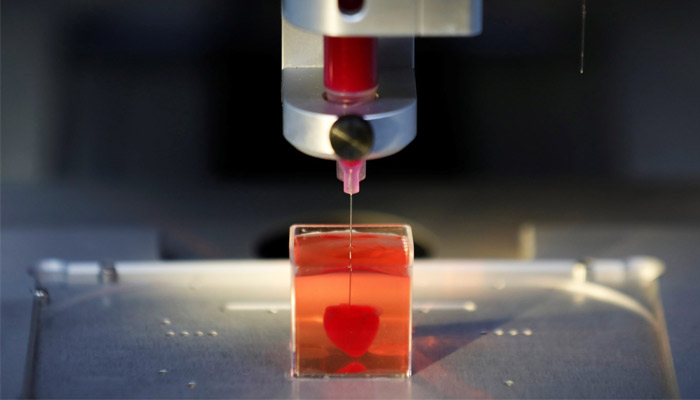3D printing has always been a fascinating technology to all that can utilize it within their industry. Put in simple terms, 3D printing entails setting down layers of material on top of each other to create almost any form and structure that we want to. The industry this blog will focus on is healthcare, where I will try to explain the technologies impacts with examples from 3 distinct categories of the utilization of 3D printing. These categories are separated by the stage of development of the technology and the extent it is already used within various subsections of the healthcare industry. Ranging from the technology being fully developed and utilized, through the technology being used but is still in development, to finally the technology only being in early developmental stages, the subsections of healthcare will be the Dental care, Prosthetics, and Bioprinting, respectively (Dodziuk, 2016).
The initial purpose for 3D printing in general was rapid prototyping and easy customization. These properties allowed the technology to easily enter the dentistry segment of the healthcare industry, due to the need for creating personalized items, which had the tendency to be extremely expensive and time costly. 3D printing allowed dentistry to leverage the technology to quickly and accurately build crowns, print their own surgical tools, and with the use of a 3D scan, instead of impressions, a 3D model of could be printed (Dodziuk, 2016). The benefits of the technology here greatly reduce the negatives of the market, by providing massive reductions in material costs and production times, thus increasing the capacity of dentists to attend more patients.
The application of 3D printing to create fully customizable prosthetics is an instance of the technology that sees an increase popularity but is not yet widely implemented. In the current market, patients face substantial costs that often do not offer customizability and in the cases of children, multiple prosthetics, since the prosthetics do not grow with them. The implementation of 3D printed prosthetics offer opportunities to fully customize the printed object, greatly reduced manufacturing times from weeks to less than a day, and the prospect of 3D printed prosthetics that grow with children is said to be soon available. Additionally, the fully customizability of the printed object allows for the increased comfortability of patients and offers further benefits by providing the opportunity for patients to gain access to assistive devices that can be attached to the prosthetics, which can be printed anywhere, by anyone that has access to 3D printing technology (Dodziuk, 2016).
Considering the monetary and time investment benefits 3D printing technology allows for within this market of the health industry, a disruption of the high cost, high production time market can be established.
Finally, the utilization of 3D printing to actually print organs, or “Bioprinting”. This technology is still in development, but there have already been successful 3D prints of human cells to create, for example, human skin grafts. What this achieves if the technology is successfully developed, is reduce the rejection of organs and other biological based materials by the host body to 0. Because these organs and others would be printed by using the patient’s own cells, the body recognizes it and will not reject or attack it instead. In addition to this, it not only makes transplants close to 100% successful, but also lowers the price of such items like organs, drastically. Instead of paying expenses of up to 300 thousand dollars for a real liver, a 3D printed, much more safe liver could cost a fraction of the cost, around 10 thousand dollars instead. This create an opportunity to treat and save more people’s lives and the enormous waiting lists for organs would be processed much quicker, much cheaper, creating a healthier world for all of us (Dodziuk, 2016).
Sources:
Dodziuk, H. (2016). Applications of 3D printing in healthcare. NCBI. https://www-ncbi-nlm-nih-gov.eur.idm.oclc.org/pmc/articles/PMC5071603/


Hi Simon!
Interesting blog post. I think it is going to be amazing to see this technology be further applied in the industry and truly disrupt the medical field, not only for the rich. What I find amazing in these new applications is that they are not only devised with eye to the western, rich civilizations, but also making it a large value-add for less developed countries and regions.
I am curious to see with what speed the technology is implemented and if the margins on the different items are truly kept on a low price. For example, an American hospital 3D printed some essential respirator parts in the midst of the Covid-19 crisis, yet got slammed with a lawsuit for intellectual property theft! (https://www.breitbart.com/tech/2020/03/18/report-respirator-valve-manufacturer-threatens-to-sue-over-3d-printed-copies-that-saved-lives/)
This brings into the picture how we are going to work with intellectual property, patents and other legal elements alongside the technology. Of course, making the initial functional prototype has its R&D costs, but to what extent is it ethical and even feasible to keep intellectual rights on these pieces, and if possible, for how long should these rights be kept? The traditional time frame seems to be outdated with the speed of this technology. Moreover, considering the Pharma industry has already been slammed for unethically high profit margins, it is going to be interesting to see how this technology further develops and if we truly reach these low prices for these items!